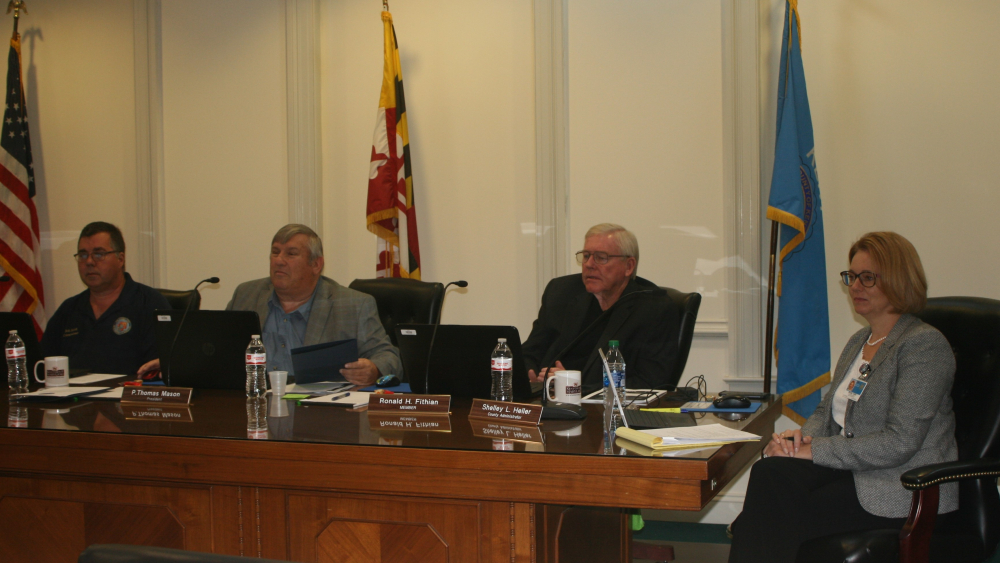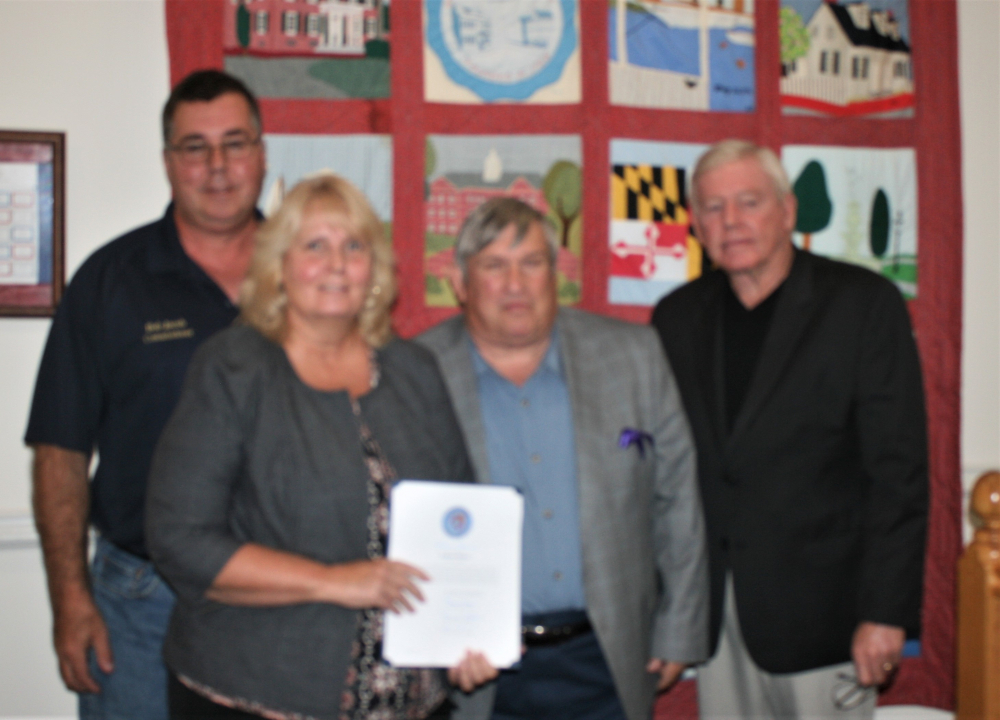
Kent County Commissioners Bob Jacob, Tom Mason, Ron Fithian, and County Administrator Shelley Heller
Riverkeepers Zack Kelleher and Tim Trumbauer of ShoreRivers gave the Kent County Commissioners an update on the health of the Sassafras and Chester Rivers at the Commissioners’ meeting Oct. 15.
Kelleher, the Sassafras Riverkeeper, opened the presentation by noting that the two rivers that bound Kent County are “special waterways,” although they are threatened by invasive species, unusually high tides, algae blooms, bacteria, debris from the Susquehanna River, and development along their banks. Climate change is a definite factor in the rivers’ condition, exemplified by the record rainfall – over 70 inches – the area received in 2018. ShoreRivers’ response is intensive monitoring of the waters, with volunteers collecting data from some 150 sites. This data can be used to help find ways to restore the rivers to health.
While monitoring these 150 sites in both rivers, Shore Rivers pays particular attention to nutrients, algae, and bacteria in the water. Kelleher observed that the data show that most pollution originates within the rivers’ watershed, as the rivers typically show the best water quality closest to their mouths on the Chesapeake Bay. But restoration projects clearly help, he said.
Chester Riverkeeper Trumbauer said the Chester River as a whole received a C+. grade, while the Sassafras received a B-, thanks to extensive restoration efforts. But the additional runoff and reduced salinity caused by the record rainfalls contributed to lower quality in both rivers. With less rainfall this year, salinity has gone back up the last few months – a good sign for organisms such as oysters. However, there were a number of algae blooms in late summer and early fall, due in part to runoff caused by the rainfall and by the unusually hot weather late last summer.
Trumbauer pointed to ShoreRivers’ “River-Friendly Yards” program in which homeowners can have a positive effect on rivers by reducing fertilizer use, installing rain gardens and rain barrels, and planting native flowers, shrubs, and trees. The riverkeeper organization is also conducting more than 100 restoration products, and it presents “a loud voice for advocacy in Annapolis.” More information is available on the ShoreRivers website.
Commission President Tom Mason asked what effect the Conowingo Dam has on the health of the rivers. Kelleher said the dam, located where the Susquehanna River enters the Chesapeake Bay, releases debris that primarily affects the main Bay and the Sassafras more than the Chester and other lower rivers. He said the effects depend on whether there have been major storms in Pennsylvania that bring debris and runoff over the dam and into the Bay. He said the impact of the dam and of the Susquehanna can be seen in regional testing.
Also at the meeting, representatives of Choptank Electric requested a letter of support for a grant proposal to bring broadband internet to rural areas of the county. They said the utility has some 54,000 customers, of whom about 2,400 live in Kent County. It operates about 6,000 miles of power lines, mostly in rural areas where there is no other provider. It also maintains about 650 miles of fiber-optic line, currently used for transferring business information. The company’s new CEO has introduced a program to extend fiber to its customers, most of whom are in areas “at the end of the line” where other providers are uninterested in extending their service. Choptank is in the process of proposing legislation in the Maryland General Assembly to facilitate its efforts to add broadband capability to customers.
Val Connelly, Choptank’s Vice President of Government and Public Affairs, said that about a third of state residents, mostly in rural areas, have no internet – including 4,100 in Kent County. She gave examples of the value of internet access to rural customers, including access to telemedicine, agricultural information, and education. Many rural children with no access at home are forced to stay after school to work on assignments, or to “surf” public internet sources, often by parking outside a business after it closes. She said that Choptank can leverage its existing assets, using its easements for electrical power to provide broadband connections. She said the Federal Communication Commission is offering $20 billion in grants for rural broadband – “and we want our share.” She said the utility would be able to provide drafts of a letter of support to local government.
Olin Davis, a member of the Choptank board of directors representing Kent County, compared the project to the electrification of rural America during the 1930s. He said that Choptank’s status as a cooperative gave it an advantage in underserved areas because it already has electrical lines and easements in those areas.
Commissioner Bob Jacob asked how soon Choptank would be able to begin hooking up customers. Connelly said it would depend on the timing of the General Assembly’s approval of the utility’s bill, but it would be as soon as possible once funding is available – possibly January 2021. The bill would be presented at the Assembly’s 2020 session.
Mason asked what the cost would be to rural customers. He said his son was quoted a price of $5,900 for a line to his house. Connelly said the amount of the grant would be a factor, but she believed Choptank would be able to connect most customers at considerable savings over other providers’ going rate.
Mason said that Kent County has been “in the forefront” of broadband service to rural areas, with a $6 million program of laying fiber-optic cable. “We want to work with what we have,” he said. Connelly said that Choptank isn’t looking to compete with existing internet providers, but to provide service to the rural customers those providers can’t or won’t reach. She said she would be happy to meet with Scott Boone, the county’s director of information technology, to find ways for Choptank and the county to work cooperatively.
Commissioner Ron Fithian said he understood how important it is to get internet to underserved areas. However, he said, he would like to see “the real product” before committing to a letter of support.
Mason said he was in favor of seeing broadband extended to “places nobody else would go – like our farm.”

County Director of Finance Pat Merritt receives a certificate of achievement for her work with the county budget. With Merritt are Commissioners Bob Jacob, Tom Mason, and Fon Fithian
In other business, the commissioners read a proclamation recognizing county Director of Finance Pat Merritt for her “consistent excellence” in managing the county’s budget and financing. Merritt gave credit to her staff and to the support and guidance of the commissioners.
Also, Janet Christensen-Lewis and Elizabeth Watson of the Kent Conservation and Preservation Alliance requested a donation of $10,000 to help the organization with a match for a grant from the Maryland Heritage Association. The grant, totaling $50,000, would allow the alliance to produce a documentary video on Kent County’s landscape and heritage. She said the film would appear on Maryland Public Television, at festivals nationwide, and would bring publicity to the county.
The commissioners, after discussion, said they would look into the budget and see if an appropriate source for the funding could be identified. They said they would make a decision by the next meeting, Oct. 29, in time for the granting agency’s deadline for matching funds.
###



Write a Letter to the Editor on this Article
We encourage readers to offer their point of view on this article by submitting the following form. Editing is sometimes necessary and is done at the discretion of the editorial staff.